
Quantum Efficiency Tester
PL/EL Integrated System
PV-Reflectumeter
3D Confocal Microscope
In-Line Four Point Probe Tester
Four Point Probe Tester
In-Line Thin Film Thickness Tester
Raman Spectrometer
FTIR Spectrometer
Spectrophotometer
Automatic Spectroscopic Ellipsometer
Contact Resistance Tester
Ultra depth of field 3D microscope
Auto Visual Tester
VMM PV Vision Measuring Machine
Solar Cell Horizontal Tensile Tester
Steady State Solar Simulator for Solar Cell
Solar Cell UV Aging Test Chamber
Solar Cell Comprehensive Tensile Tester
Visual Inspection Tester
Wet Leakage Current Tester
PV Module EL Tester
PV Module UV Preconditioning Chamber
Steady State Solar Simulator for PV Module
Current Continuous Monitor
Potential Induced Degradation Test
Bypass Diode Tester
LeTID Test System
Reverse Current Overload Tester
Impulse Voltage Tester
Hipot Insulation Tester
Ground Continuity Tester
Hipot Insulation Ground Tester
Damp Heat Test Chamber
Humidity Freeze Test
Thermal Cycle Test Chamber
Dynamic Mechanical Load Tester
Static Mechanical Load Tester
Hail Impact Tester
Robustness of Termination Tester
Module Breakage Tester
Cut Susceptibility Tester
Peel Shear Strength Tester
Universal Testing Machine (Single-arm)
Universal Testing Machine (Double-arm)
Glass Transmittance Tester
Acetic Acid Test Chamber
EVA Degree of Crosslinking Test System
Junction Box Comprehensive Tester
Drop ball tester
Semi-automatic scanning four-probe tester
Stylus Profilometer
Maximum Power Point Tracker
Perovskite Glass Transmittance Tester
Perovskite P1 Laser Scribing Multifunctional Testing Machine
Perovskite Online PL Tester
Perovskite Online Sheet Resistance Tester
Online Perovskite Film Thickness Tester
Perovskite Process Inspection Workstation
Portable IV Curve Tester
Portable EL Tester
Portable Thermal Imaging Tester
Solar Module Multi-Channel Testing System
PV Inverter Power Quality Tester
Drone EL Tester
IV Tester
IVEL Cell Sorting Machine
Analysis of All-perovskite and Perovskite/crystalline Silicon Tandem Solar Cell Technologies
Date : 2024-03-14Views : 190
In recent years, perovskite tandem solar cell technology has developed rapidly, and the cell efficiency has exceeded 30% because it consists of two cells with different bandgap absorbers. By differentially absorbing sunlight with a wider range of wavelengths, photothermal loss is reduced, thereby improving cell conversion efficiency. Millennial Spectrophotometer is a detection instrument used to measure the transmittance, reflectance and absorbance of thin film materials such as ITO, amorphous silicon, microcrystalline silicon, etc., with a wavelength range of 190 to 2800 nm. It is equipped with new control and data processing software. Provides strong support for efficiency analysis of perovskite tandem solar cells.
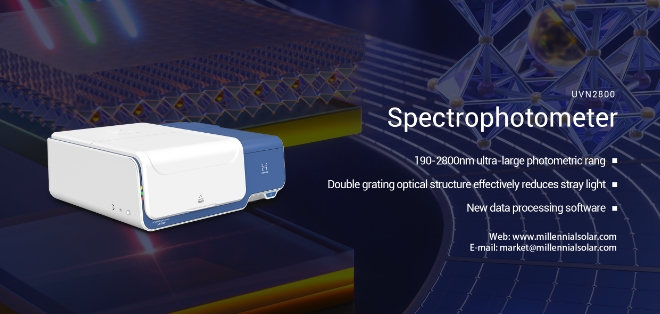
The concept of laminated (tandem) solar cells
In 1994, the concept of tandem solar cells was first proposed. The solar spectrum can be divided into several consecutive parts, and materials with matching band gap widths can be used to form tandem (tandem) solar cells. In order to obtain the highest possible photoelectric conversion efficiency, stacked cells should meet basic requirements such as material lattice matching, reasonable combination of bandgap widths, and top-bottom cell current matching.
The current densities of stacked cells are generally different, and the current mismatch between the top and bottom cells will greatly affect the cell performance. Trying to get a cell-matching structure is key to ensuring good performance in stacked cells. The top cell of the tandem cell uses a wide-bandgap absorber layer to efficiently convert the short-wavelength spectrum to minimize light loss; the bottom cell uses a narrow-bandgap absorber layer to capture near-infrared photons to maximize current density. When the device is illuminated by light, the wide-bandgap top cell absorbs short-wavelength photons with energy higher than its band gap, producing a high open circuit voltage (VOC), while the narrow-bandgap bottom cell absorbs long-wavelength photons. Reduce light and heat loss and improve photoelectric conversion efficiency.
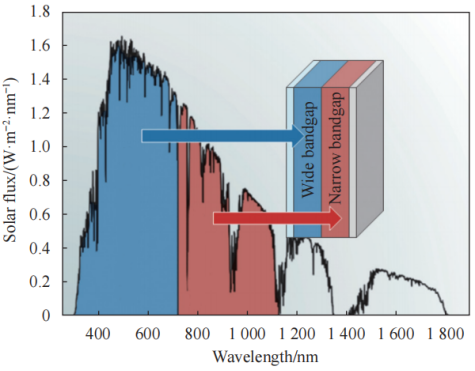
Schematic diagram of dual-junction stacked cells utilizing the solar spectrum in different wavelengths
Structure of laminated (tandem) solar cells
Stacked cells can be divided into two structures. One is a stacked cell at both ends, including two sequentially prepared sub-batteries and an interconnection layer connected to the two. The structure is simpler and the production cost is relatively low, but the top and bottom Factors such as optical coupling, manufacturing process compatibility, and the optical and electrical balance of the interconnect layer will affect cell efficiency.
The other is a four-terminal stacked cell, which consists of two independent cells stacked and connected through an external circuit. It is simple to prepare, but doubled metal electrode consumption and component-side process responsibility limit large-scale application prospects.
The figure below shows the two structures of all-perovskite tandem cells:
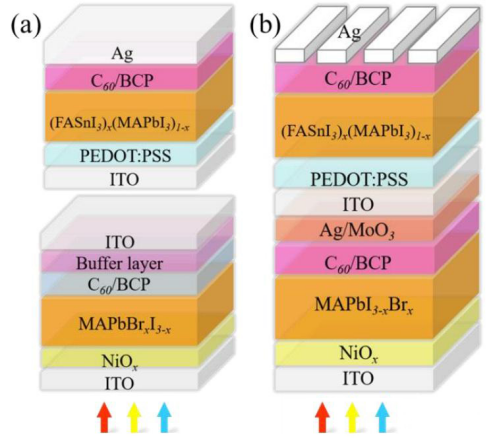
(a) Four-terminal (4-T) all-perovskite tandem solar cell; (b) Two-terminal (2-T) all-perovskite tandem solar cell
Perovskite/crystalline silicon tandem cells
Perovskite solar cells (PSCs) have the advantages of high light absorption coefficient, long carrier diffusion length, adjustable band gap, up to 25.2% single-cell PCE and easy fabrication, making them an ideal choice for stacked top cells. And it can match the band gap of crystalline silicon solar cells, perovskite solar cells, organic solar cells, and copper indium gallium selenide solar cells.
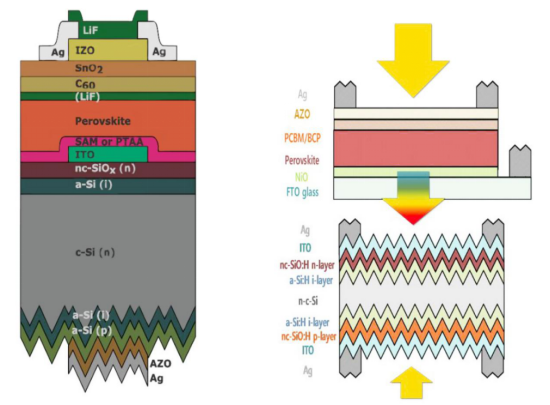
Schematic diagram of the structure of a perovskite/heterojunction tandem solar cell (left: two-terminal type, right: four-terminal type)
Precise control of the interface state, non-radiative recombination and photoelectric coupling between sub-cells of wide-bandgap perovskite cells can improve the photoelectric conversion efficiency of the cells. Ideally, the top cell should achieve full absorption of the ultraviolet and visible spectrum in the 300-750nm range and no absorption of the wider long-wavelength spectrum. This requires the optical band gap of the perovskite absorber to be as wide as possible (1.67-1.75 eV), but this results in severe non-radiative recombination losses. The optical and electrical properties of the interconnect layer also have an impact on overall cell efficiency.
All-perovskite stacked cells
The all-perovskite tandem cell is integrated with a wide-bandgap perovskite sub-cell on the top and a narrow-bandgap perovskite sub-cell on the bottom. Its advantage is that the band gaps of both sub-cells can be flexibly adjusted to maximize the Efficient utilization of the solar spectrum is achieved, and Voc exceeds that of perovskite/crystalline silicon stacked cells. However, there are still three factors that limit the efficiency of all-perovskite tandem cells.
First, the stability of narrow-bandgap sub-cells is affected by the easy oxidation of Sn2+.
Second, the interconnection interface of all-perovskite tandem cells is planar, and the light reflection at the planar interface reduces the long-wavelength spectrum utilization of narrow-bandgap sub-cells.
Third, there is a risk of solvent degradation during the deposition process of narrow-bandgap subcells.
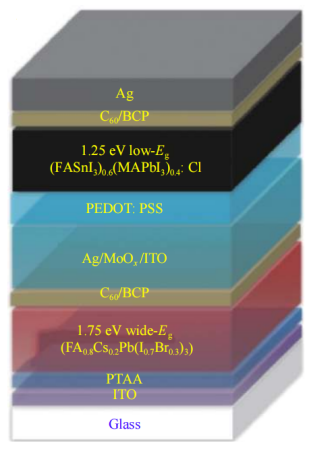
Schematic diagram of the structure of an all-perovskite tandem solar cell
Currently, among perovskite stacked cells, perovskite/crystalline silicon stacked cells and all-perovskite stacked cells have higher efficiencies. They are also the main research direction of most perovskite cell manufacturers in recent years, with efficiencies ranging from 23.5 % increased to 33.9%.
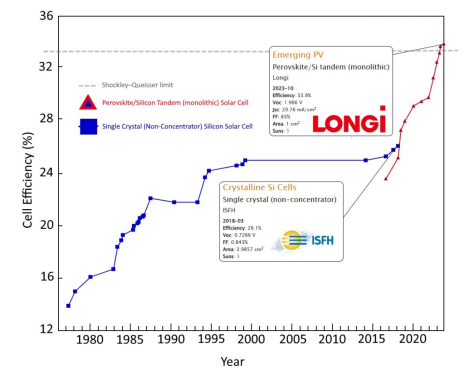
Perovskite/crystalline silicon tandem solar cell efficiency in recent years
Spectrophotometer UVN2800
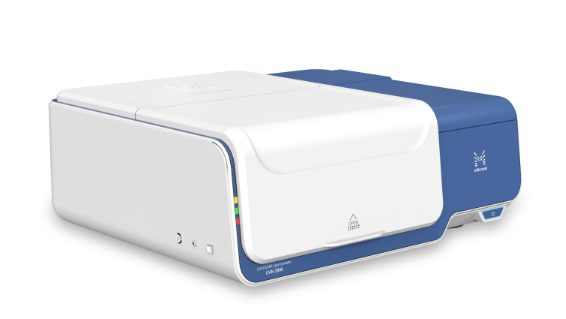
E-mail: market@millennialsolar.com
Spectrophotometer supports the measurement of solar transmittance in a wide range of wavelengths from the ultraviolet region to the near-infrared region, providing strong support for solar cell efficiency analysis. The equipment adopts a unique dual-beam optical design, which can perfectly correct the absorbance changes of different sample matrices, so that the sample can be measured stably. It has the advantages of wide testing range, high precision and good stability.
● Adopt dual light source and dual detector design, wavelength range 190-2800nm
●Double grating optical structure effectively reduces stray light
● The diameter of the integrating sphere can reach 100mm. It will not turn yellow after long-term use and has stable optical performance
In the context of the "double carbon" goal, high-efficiency photovoltaic power generation technology, as one of the clean energy technologies with the greatest potential to replace traditional petrochemical resources, has been listed as a key support and priority development target by the state. Reducing power generation costs and improving conversion efficiency have always been the core goals of photovoltaic power generation technology. At present, the experimental efficiency of perovskite-containing stacked cells has exceeded that of single perovskite cells, fully demonstrating that the stacked structure is an effective method to achieve more efficient use of solar energy. Millennial Solar provides the UVN2800 spectrophotometer, which provides accurate measurement of transmittance, reflectance and absorbance data of thin film materials.

































































